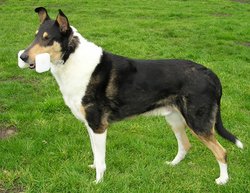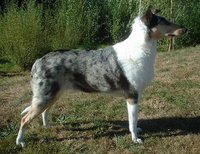
|
From Wikipedia the free encyclopedia, by MultiMedia |
| Smooth Collie | |
|---|---|

Tricolor Collie with training
dumbbell.
|
|
| Alternative names | |
| Collie (Smooth Coat) | |
| Country of origin | |
| Scotland | |
| Common nicknames | |
| Classification and breed standards | |
| FCI: | Group 1 Section 1 #296 |
| AKC: | Herding |
| ANKC: | Group 5 (Working Dogs) |
| CKC: | Group 7 - Herding Dogs |
| KC (UK): | Pastoral |
| NZKC: | Working |
| UKC: | Herding Dogs |
| Not recognized by any major kennel club | |
| This breed of Dog is extinct | |
| Notes | |
A Smooth Collie is a breed of Dog developed originally for herding. It is a short-coated version of the Rough Collie of Lassie fame. Some breed organizations consider the smooth-coat and rough-coat Dogs to be variations of the same breed.
 Blue merle Smooth Collie
Blue merle Smooth Collie
The Smooth Collie is a medium to large Dog, ranging in size from 20-26 inches at the shoulder and weighing 40-75 pounds. Standard size for the breed is on the larger end of the range in the United States and Canada, smaller elsewhere; for example, for the AKC, the range is 22 to 26 inches (56-66 cm) and 50 to 75 pounds (22.5-34 kg). In all standards, females should be significantly smaller than males. The Smooth Collie is slightly longer than it is tall, with a level back and a deep chest. The features of the head, particularly the "sweet" expression, are considered very important in the show ring. The breed has a long muzzle, flat skull, and semi-erect ears (although, in practice, the ears typically must be folded over and taped in puppyhood, or they will be fully upright in the adult Dog).
The coat consists of a soft, extremely dense undercoat and straight, harsh outer guard hairs. The guard hairs are one to two inches long, with the longer hair mainly in a ruff around the neck and on the backs of the thighs. The coat requires a thorough weekly brushing. Shedding is moderate most of the year, heavy during the twice-yearly shedding season.
Smooth Collies come in four colors, three of which are considered acceptable by all standards worldwide. The universally accepted colors are sable (Lassie's color; can be light gold to deep mahogany), tricolor (mainly black with tan markings), and blue merle (silvery gray marbled with black), all marked with white areas on the chest, neck, feet/legs, and tail tip. Kennel clubs in the United States and Canada also accept white, sometimes called color-headed white. These Collies are predominantly white, with heads (and usually a body spot) of one of the other three colors.
The Smooth Collie is generally a sociable, easily trained family Dog. Although not an aggressive breed, they are alert and vocal, making them both good watchDogs if well trained and potential nuisances if allowed to bark indiscriminately. This breed of Dog needs a lot of attention and is not for the inexperienced Dog owner. Training this breed requires a light touch, as they are sensitive to correction and will balk at harsh treatment. They get along well with children and sometimes other animals, usually getting along with other Dogs. Smooth Collies tend to have retained more herding instincts than the rough variety, and have noticeably higher energy levels.
Smooth Collies are used both as family pets and in obedience competition, agility, herding trials, and other Dog sports. Some are still used as working sheepDogs. They are also useful as service animals for the disabled, and are being trained in some instances as guide Dogs for the blind.
The Smooth Collie is a long-lived breed for its size, usually living 14 to 18 years. Like all Dog breeds, they are susceptible to certain inherited or partially inherited health problems. Those problems currently include:
The early history of the Smooth Collie, like that of many Dog breeds, is largely a matter of speculation. The most common view of the breed is that they are descended from a population of shepherds' Dogs brought to Scotland by the Romans around the 5th century. Even the origin of the breed's name is unclear, variously claimed to describe the early shepherd Dog's dark color ("coaly"), or derived from the name of a breed of sheep once commonly kept in Scotland ("Colley").
The modern history of both the Smooth and Rough Collie began in the reign of Queen Victoria, who became interested in the shepherds' Dogs while at Balmoral Castle in Scotland. In 1860, she purchased some of the Dogs for her own kennel. With the Queen's interest, it became fashionable to own Smooth Collies. Thus began the breed's transformation from working farm Dog, similar to the modern Border collie, to the largely pet and show Dog we know today.
The Smooth Collie today is considered a variety of the same breed as the Rough Collie in countries such as the United States and Canada, meaning that they can interbreed and some statistics are kept only for "Collie" rather than for both varieties individually. The smooth and rough are classified as separate breeds in other countries, such as the United Kingdom and Australia. The latter is a fairly recent development, however, with the Kennel Club (UK) allowing the interbreeding of the two varieties until 1993.
Dogs, made by MultiMedia | Free content and software
This guide is licensed under the GNU Free Documentation License. It uses material from the Wikipedia.